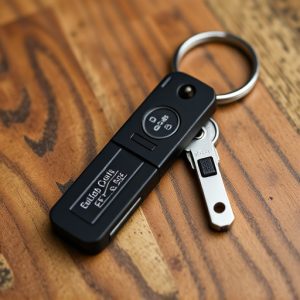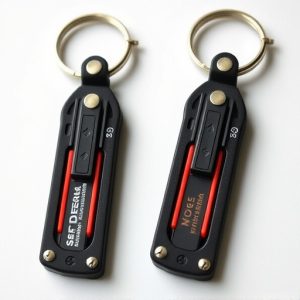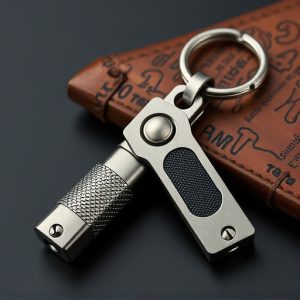Mastering Self-Defense: Optimal Keyring Design and Striking Techniques
Tactical keyrings, combining convenience with strategic design, offer versatile self-defense tools f…….
Tactical keyrings, combining convenience with strategic design, offer versatile self-defense tools for everyday carry. Mastering the best keychain weapon striking points—from sharp edges to rounded ends—enables users to defend themselves effectively in various scenarios. Prioritizing grip security and ergonomic design, these keyrings empower individuals to leverage everyday items as potent defense mechanisms, emphasizing practice, precision, and de-escalation tactics for real-life applications.
“Unleash your personal defense power with a tactical keyring—a compact, versatile tool designed to keep you safe. This comprehensive guide explores the art of self-defense through keyring grip design, from understanding strategic designs to identifying the most effective striking points on a keychain weapon. We delve into key features that enhance grip and control, ensuring precision in high-pressure situations. Additionally, we provide safety considerations for responsible self-defense training, empowering you to make informed choices when carrying a tactical keyring as your secret ally.”
- Understanding Tactical Keyring Designs for Self-Defense
- Best Keychain Weapon Striking Points: A Comprehensive Guide
- Keyring Grip Design Features and Their Efficiency
- Training and Safety Considerations for Effective Self-Defense Keychains
Understanding Tactical Keyring Designs for Self-Defense
In the realm of self-defense, tactical keyring designs have emerged as a practical and discreet way to empower individuals. These compact tools are designed with strategic thinking, incorporating various striking points for effective defense in tight spaces. Understanding the best keychain weapon striking points is paramount; each point serves a unique purpose, offering versatility in different scenarios. For instance, a sharp edge can be used for cutting or disarming attackers, while a flat surface provides leverage and impact for stunning or distracting an opponent.
Tactical keyrings are not just about functionality; they also prioritize user safety and comfort. Well-designed models feature ergonomic grips that ensure a secure, non-slip hold during stressful situations. By combining the everyday convenience of a keychain with strategic weapon design, these tools offer peace of mind for those who value being prepared. Whether it’s for personal protection or as a backup defense mechanism in unexpected places, tactical keyring designs are revolutionizing self-defense options.
Best Keychain Weapon Striking Points: A Comprehensive Guide
When considering a keychain weapon for self-defense, understanding the best striking points is crucial. The design and functionality of a tactical grip keyring should prioritize strategic locations that maximize its impact. For instance, the edge of a flat edge keyring can effectively deliver powerful strikes to sensitive areas like eyes, throat, or groin. Rounded or pointed ends can also be utilized for thrusting motions, targeting vital spots like the nose, solar plexus, or side of the head.
A comprehensive guide on best keychain weapon striking points would include illustrations and demonstrations of various techniques. It should emphasize the importance of practice and precision, ensuring users are comfortable with the tool’s range and effectiveness before relying on it in real-life situations. Understanding these striking points equips individuals to defend themselves confidently, leveraging everyday carry items as potent self-defense tools.
Keyring Grip Design Features and Their Efficiency
The design of a tactical keyring grip plays a pivotal role in its overall effectiveness as a self-defense tool. Key features such as a textured surface and ergonomic shape are crucial for ensuring a secure, comfortable grip under pressure. A well-designed keyring should allow for quick access to the striking points, enabling users to deploy it with precision and force when needed.
Efficient keyring grips often incorporate multiple striking surfaces, strategically placed for various hand positions. This versatility allows for more versatile self-defense options, making it an invaluable tool in unexpected situations. By focusing on these design elements, creators aim to provide users with a compact yet powerful defense mechanism that can be easily carried and readily available when danger lurks.
Training and Safety Considerations for Effective Self-Defense Keychains
When training with a self-defense keychain, understanding safe and effective striking points is crucial. The best keychain weapon designs incorporate tactical grips that enable precise control during practice sessions. Users should focus on targeting vulnerable areas like the throat, eyes, groin, or knees to maximize impact while minimizing risk of injury. Training should involve simulated scenarios, emphasizing proper hand placement, grip strength, and timing.
Safety is paramount; always wear protective gear during training and ensure a controlled environment free from bystanders. Regular practice with a variety of techniques allows individuals to develop muscle memory in case of an actual emergency. Remember, the keychain is designed to be a last resort; prioritize de-escalation and avoidance whenever possible.
Choosing a self-defense keyring with an efficient grip design and strategic striking points can significantly enhance your personal safety. By understanding tactical keyring designs and training with them responsibly, you can turn this compact tool into a powerful asset. Remember, while these keychains offer additional protection, they should complement existing self-defense strategies rather than replace them entirely. Stay prepared, stay safe.


